Move your office to the view that inspires you. Tiny living now pairs cozy design with practical places to focus. A tiny home on wheels keeps routines, tools, and comfort intact as you travel.
Modular options arrive nearly finished, cutting build time and stress. Many include bright windows, smart storage, and a dedicated desk zone that supports daily work. Solar panels, battery backup, and rainwater systems add resilience and lower bills.
Choose a stationary tiny house sited in a quiet spot to create a focused studio. Or pick a towable model that lets you chase seasons, the coast, or mountain trails while staying connected. Nomad Tiny Homes and similar builders offer handcrafted models like The Nomad, The Escape, The Hideaway, and The Homestead with nationwide delivery.
This Ultimate Guide will help you weigh choices, plan budgets, and design a home that supports freedom, flexibility, and the modern lifestyle you want.
Key Takeaways
- Movable tiny homes keep your daily routine intact while you travel.
- Modular builds shorten timelines and reduce construction stress.
- Designs prioritize light, storage, and a dedicated workspace.
- Sustainable systems cut costs and boost independence.
- Established builders make setup and delivery easier across the U.S.
Why portable homes fit the remote work revolution right now
Remote schedules let people pick scenery and community over commute time. That shift gives many the freedom to choose neighborhoods and landscapes that boost health and focus rather than rent or office proximity.
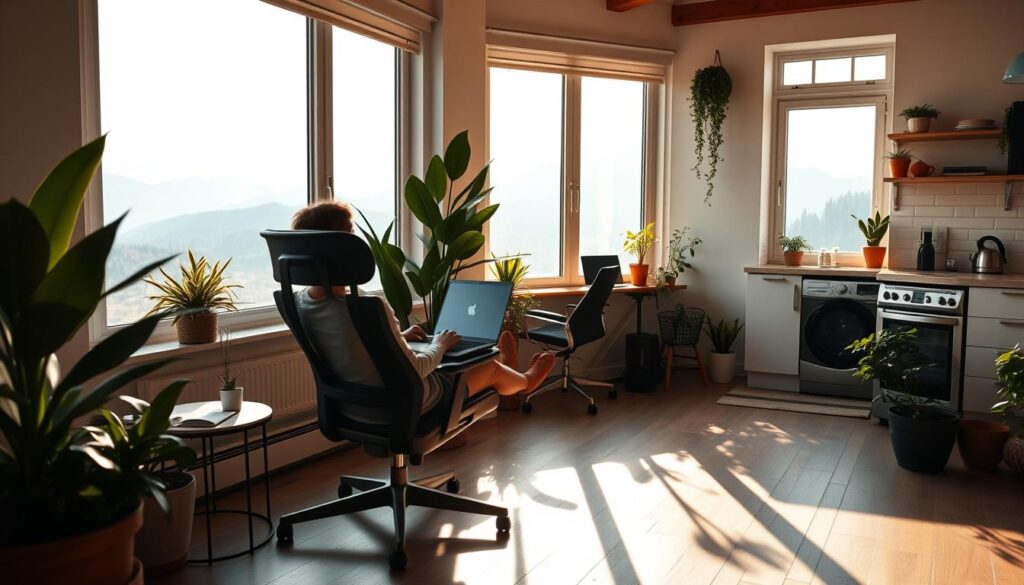
Freedom to choose location over proximity to an office
Remote work decouples where you live from where you work. Workers can chase quiet areas with more space and better outdoor access.
This change stretches budgets in lower-cost regions, freeing money for savings, wellness, or travel.
Shifting priorities: space, comfort, and quality of life
Many now value a dedicated office zone, good daylight, and acoustic control. Those comforts improve sleep, reduce stress, and boost daily output.
Modular builds often arrive mostly finished, which helps bypass rural delays and limited local trades. That creates a more predictable move-in and more stability when you change locations or assignments.
- Try before you commit: test areas without long-term ties.
- Year-round designs mean durability and real-world living.
- Tailored layouts deliver ergonomic performance without city rents.
Understanding your options: tiny homes on wheels vs modular homes
Deciding between a towable tiny home and a factory-built modular unit comes down to how much you value movement versus permanence.
Mobility and stability
Mobility and stability: tiny homes on wheels for working anywhere
A tiny home on wheels lets you travel to new locations while keeping the same setup. You can follow client work, chase seasons, or seek fresh views without losing comfort.
These rigs keep bedrooms, kitchens, and desks intact. Expect towing, parking rules, and weight limits as part of living in a moving unit.
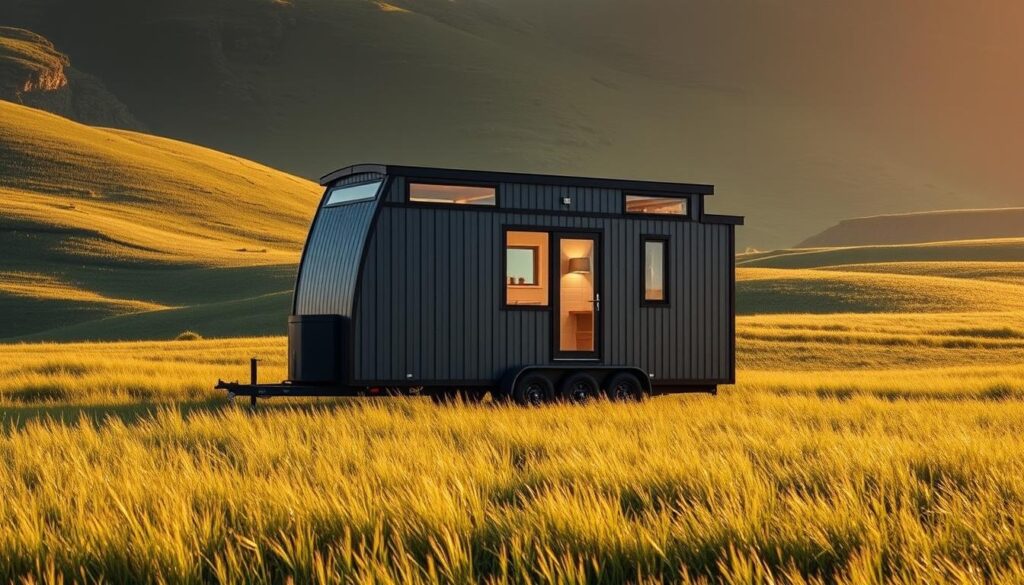
Factory-built efficiency: modular homes with faster move-in timelines
Modular units arrive roughly 90–95% complete. That reduces weather delays and local trade shortages.
Modular builds offer predictable schedules, larger footprints, and more layout options. That makes them great as a stable base in scenic locations.
Stationary bases in scenic areas for focus, nature, and creativity
Placing a tiny house or modular unit near a lake or mountain can spark deep work and lower stress.
Both approaches can include quality finishes, ergonomic office zones, and efficient systems to save energy.
| Feature | Tiny home on wheels | Modular home | Best fit |
|---|---|---|---|
| Mobility | High — move between locations | Low — installed on site | Seasonal travel vs stable base |
| Move-in speed | Depends on build time | Fast — 90–95% factory complete | Quick occupancy vs travel readiness |
| Design & comfort | Compact, efficient design | Larger layouts, more choices | Right-sized living vs expanded space |
- Consider a hybrid plan: a scenic modular base plus a small travel rig for short adventures.
- Think through parking, foundations, utilities, and local rules before choosing.
Portable homes for remote work and digital nomads
When you build daily life around flexibility, the space you occupy becomes a tool for productivity. Tiny living rewards intentional choices: less clutter, lower costs, and routines that support deep focus.
Designing a lifestyle around flexibility, simplicity, and comfort
Prioritize an ergonomic workstation, daylight, ventilation, and smart storage. These features make small spaces feel larger and support better output.
Comfort matters. Quiet, temperature control, and supportive seating improve concentration and reduce fatigue.
Link your values to design choices. Pick durable materials, solar-ready systems, and layouts that mirror what you value in daily life.
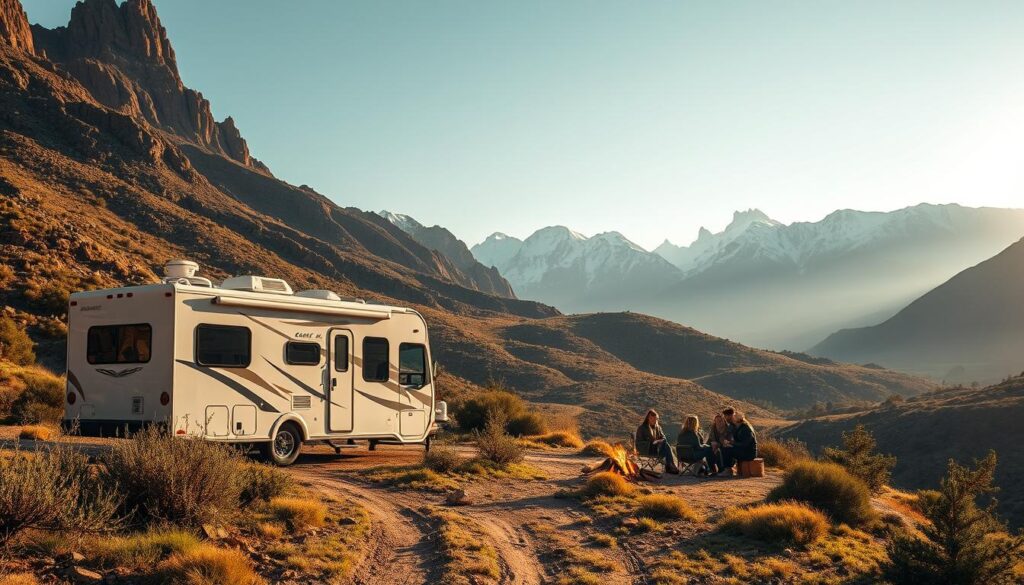
- Frame this as an intentional lifestyle that prizes simplicity and flexibility.
- Use fold-down desks, multipurpose seating, and built-in storage to save space.
- Create clear zones—work, rest, cook, recharge—to give your brain cues.
- Keep possessions lean to lower decision fatigue and boost personal growth.
Document routines and tweak layouts until your choices align with performance and well-being. The right design turns a small space into a calm, capable home that supports both life and career momentum.
Designing your workspace: turning small spaces into productivity hubs
A focused desk, smart storage, and clear zones turn a tiny footprint into a high-performance office. Many models arrive with a dedicated desk area, strong daylight, and even off-grid power to keep you productive.
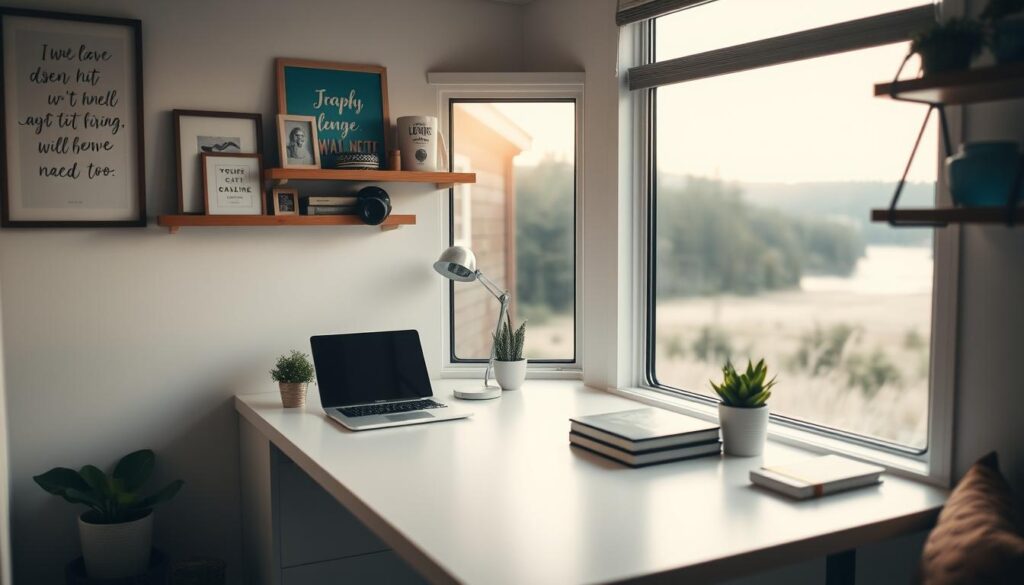
Dedicated office zones, soundproofing, and ergonomic layouts
Start with an ergonomic plan: set desk height, monitor placement, and a supportive chair to protect posture during long sessions.
Sound matters. Add acoustic panels, thick rugs, and door seals to cut noise and improve call clarity for remote meetings.
Natural light, storage solutions, and multipurpose furniture
Place the desk near a window and add task lighting for evening hours. Use blackout shades to control glare on video calls.
Build storage into the structure—under-seat drawers, wall organizers, and loft cubbies keep gear handy without clutter.
On-the-road offices: taking your setup wherever you go
Pack a clamp-on monitor arm, a compact mechanical keyboard, and a folding chair so your station travels with your tiny home.
- Plan cables and outlets where you sit. Include USB-C PD and an uninterruptible power supply.
- Keep a 5G hotspot and directional antenna as a connectivity kit, and use co-working spaces nearby for team sprints.
Connectivity and power: staying online and off-grid
A reliable network plan keeps your calls clear and your uploads steady, even off-grid. Start with a primary landline broadband where available, then add a 5G hotspot with an external antenna as a backup for travel or rural areas.
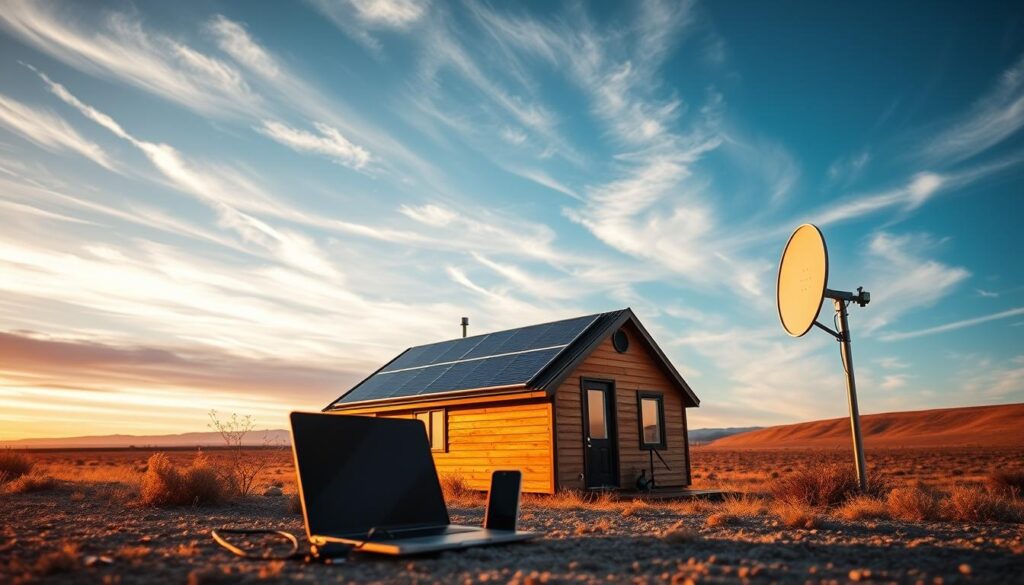
High-speed internet setups and mobile hotspots
Choose a router that supports failover, bonding, and QoS so video calls and large uploads don’t drop during hiccups. Carry a secondary carrier SIM and a travel-friendly antenna to address coverage gaps.
Pro tip: keep a small “go bag” with spare cables, SIMs, a power bank, and a compact travel router to stay productive in any area.
Solar panels, energy-efficient appliances, and battery planning
Size solar to match daily watt-hours for your laptop, monitor, router, and lights. Pair panels with lithium batteries to bridge cloudy days and add a compact UPS at the desk to prevent brief outages from killing momentum.
- Pick energy-efficient kit: an induction cooktop, heat-pump mini-split, and a DC fridge to cut draw and extend off-grid time.
- Insulate well, tighten air sealing, and use a smart thermostat to keep a stable environment for you and your gear.
- For tiny home setups, place battery banks low and centered, and secure panels and wiring against vibration.
“Off-site modular assembly reduces noise, waste, and site impact, protecting the environment around your site.”
Confirm cellular coverage maps before you move and plan a primary plus backup internet plan. Thoughtful power and connectivity choices boost efficiency, sustainability, and your ability to work from nature with confidence.
Sustainability and values: living lighter with smart design
Small-footprint design often means fewer resources used from day one. Right-sized living lowers embodied carbon and trims ongoing energy use by reducing square footage and material needs.
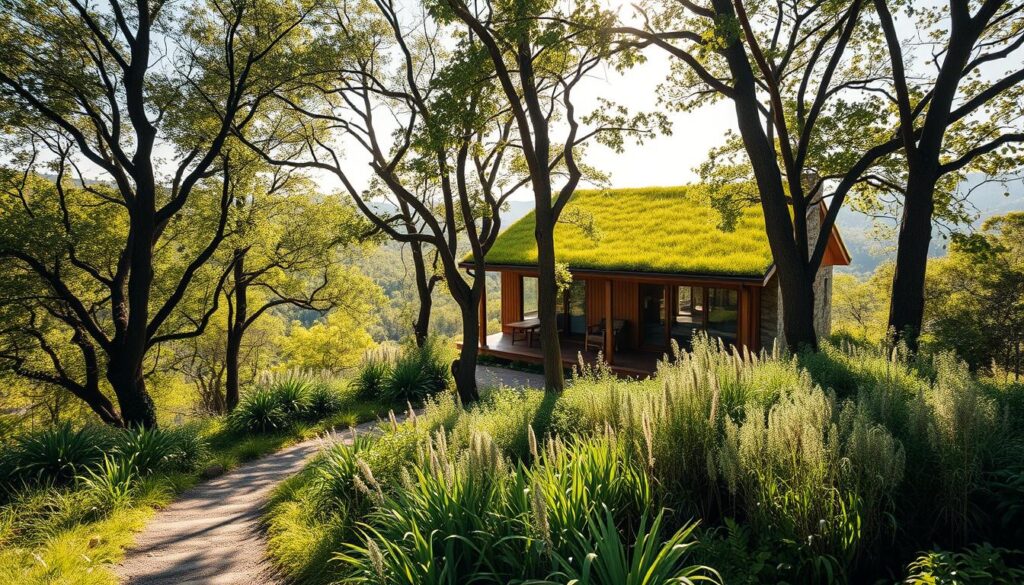
Reduced footprint through right-sized living
Living in a compact house cuts material demand and heating loads. Smaller spaces are easier to heat, cool, and maintain.
Off-site construction that minimizes waste and site impact
Factory-built modules keep surplus materials indoors where they are reused. Off-site assembly also reduces noise, dirt, and long on-site workdays.
Composting toilets, rainwater systems, and eco-minded choices
Choose systems that shrink utility dependence. Solar arrays, composting toilets, and rainwater harvesting lower bills and reduce strain on the environment.
Aligning lifestyle and environment with long-term values
Invest in durable finishes and efficient HVAC to save money and resources over the home’s life. Pick repairable, recyclable materials and low-impact site work like minimal grading.
- Community benefits: clustered units can share gardens, tools, and EV charging.
- Starter eco-checklist: LED lighting, induction cooking, low-flow fixtures, airtight construction.
- Design for circular use: choose materials that can be repaired or reused.
“Sustainable design doesn’t mean sacrifice — it often improves daily comfort and aligns your life with your values.”
Community and belonging: finding your people on the road
Many tiny home clusters now center on shared kitchens, co-working nooks, and weekly meetups.
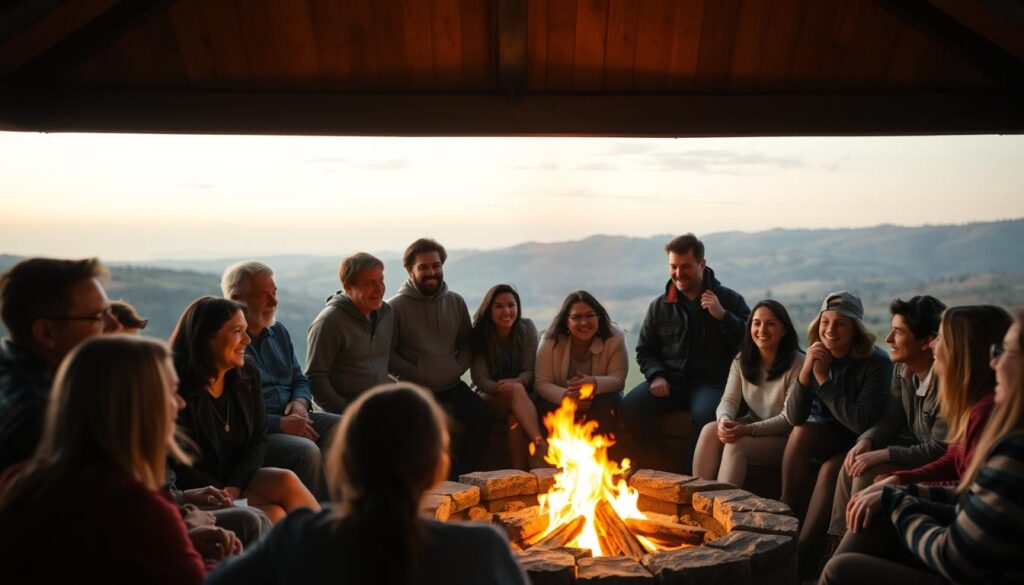
These communities offer a built-in network with shared Wi-Fi, co-working spaces, and social events that beat isolation. You keep your private home while enjoying communal fire pits, gardens, and maker areas.
Tiny home communities with shared resources
Shared amenities lower costs and extend daily options. Sites often include tool libraries, laundry, and meeting rooms that support entrepreneurship and creative projects.
Balancing independence with connection
Connect with fellow travelers to swap routes, repair tips, and client leads. That peer network can accelerate growth and spark new collaborations.
- Join skill-share nights, mastermind circles, or volunteer hikes to build bonds.
- Host small gatherings on a deck or awning for dinners, jam sessions, or yoga.
- Follow simple etiquette: quiet hours, parking norms, and shared resource guidelines.
| Amenity | Benefit | Good for |
|---|---|---|
| Shared Wi‑Fi & co-working spaces | Stable connectivity, meeting spots | Remote calls, focused sprints |
| Community gardens & fire pits | Social life and low-cost meals | Relaxing evenings, local ties |
| Maker spaces & tool libraries | Lower startup costs for projects | Entrepreneurs, repair swaps |
“Try a short-term stay in a tiny community to feel the rhythm before you commit.”
Practicalities: budgets, timelines, and legal considerations
Plan delivery logistics early — they shape costs, timing, and where you can legally park or place a unit.
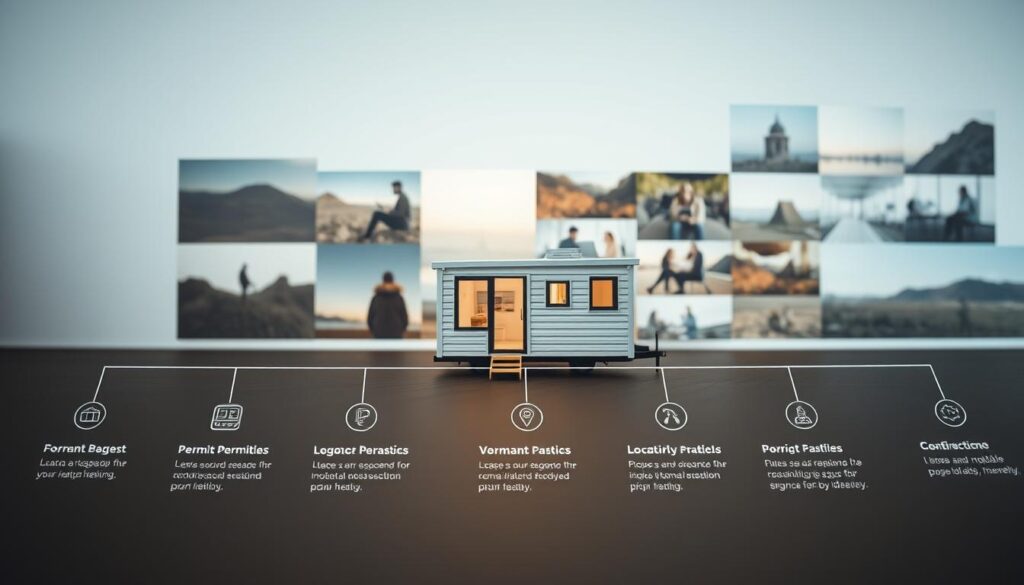
Build time and delivery: from factory floor to your site
Modular units often arrive 90–95% complete, which shortens on-site time and lowers weather-related delays. That off-site process also cuts noise and waste at your property.
Budgeting for housing, utilities, and maintenance
Budget holistically: include transport, site prep, permits, utility connections or off-grid gear, insurance, and routine maintenance.
Tip: get line-item quotes for delivery, foundation or parking setup, and any required inspections.
Zoning, parking, and siting basics
Check local codes early. A unit on wheels may be classed as an RV in some counties, while modular units usually need foundations and inspections.
Research county rules, HOA limits, snow-load standards, wind zones, and wildfire areas before you finalize a site.
Choosing between custom builds and proven models
Custom builds match one person’s workflow and storage needs. Proven models reduce decision fatigue, cut change orders, and speed delivery.
- Plan for stability if you’ll stay long-term: invest in insulation, durable systems, and expanded storage.
- If you plan on moving often, simplify systems and reduce weight for easier travel.
- For working anywhere, prepare mobile connectivity and power redundancies before arrival.
“Get quotes from reputable U.S. builders with clear specs, solid references, and transparent warranty terms.”
Next steps to start your portable home journey
Start by defining what “right tiny” means for your life — list must-haves for your daily routine, preferred locations, and how you want to earn a living. Keep the list short to stay focused.
Draft a clear budget and timeline that includes purchase, delivery, setup, solar, battery, and a cushion for surprises. Shortlist reputable builders such as Nomad Tiny Homes and compare specs, insulation, warranties, and photos.
Test a model with a short stay. Plan connectivity and power before arrival. Map nearby communities, co-working spots, and fellow travelers to build a sense of belonging and fuel personal growth.
Take action: contact a trusted U.S. builder, pick a model or custom path, and book your production slot to begin this life of more freedom and flexibility.
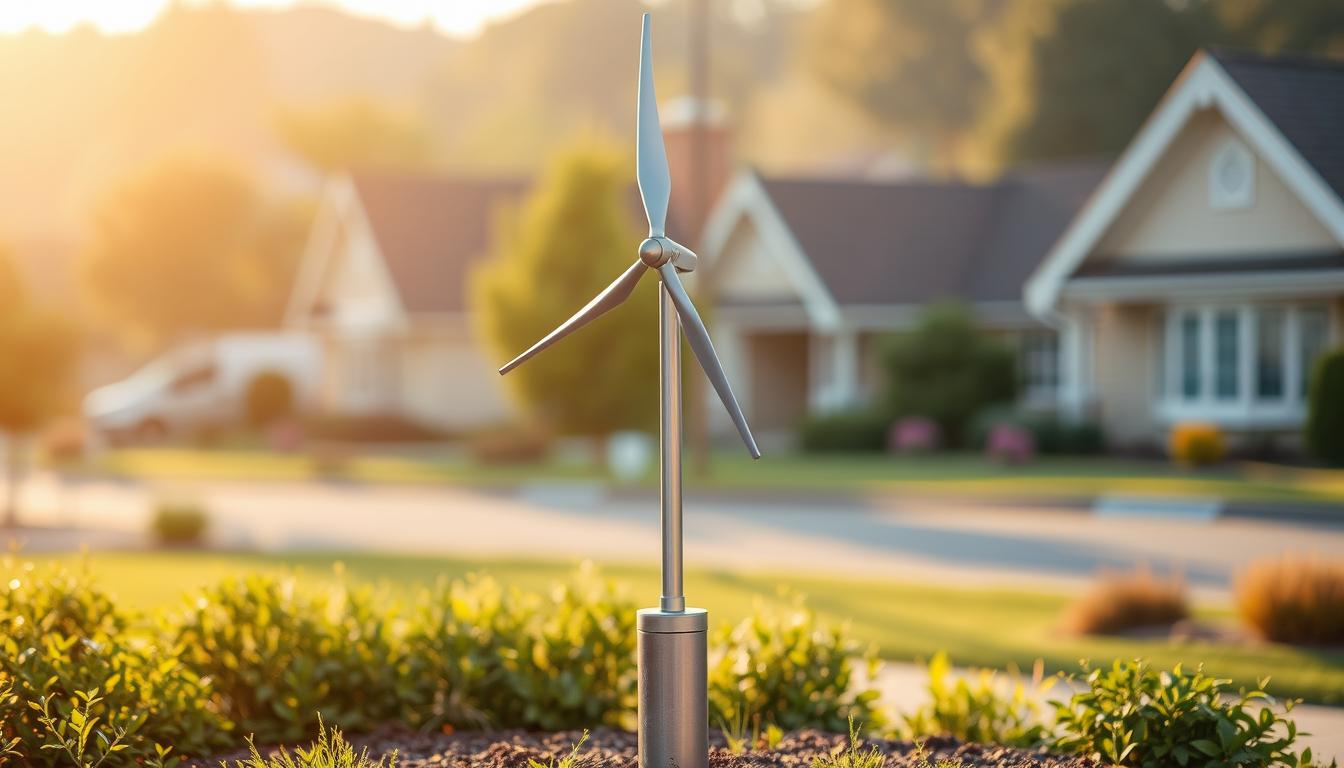
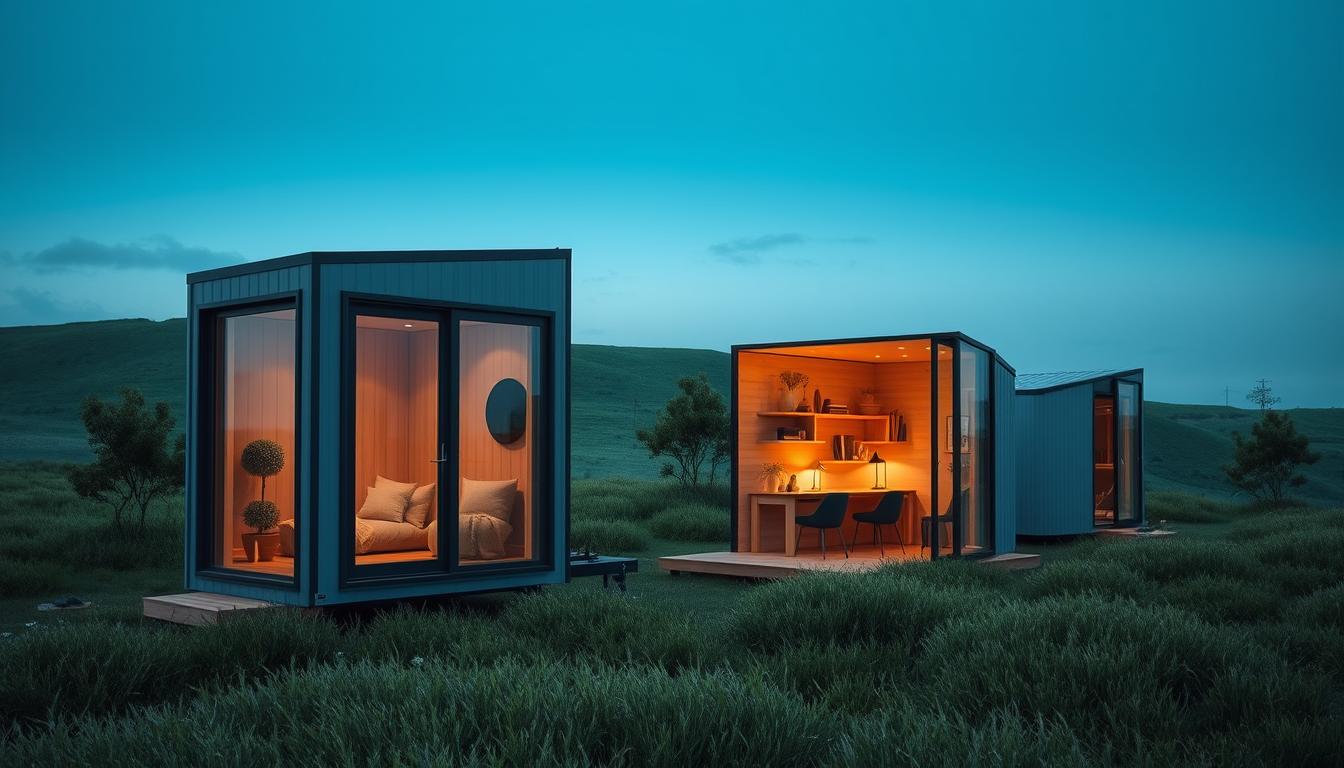
Leave a Reply